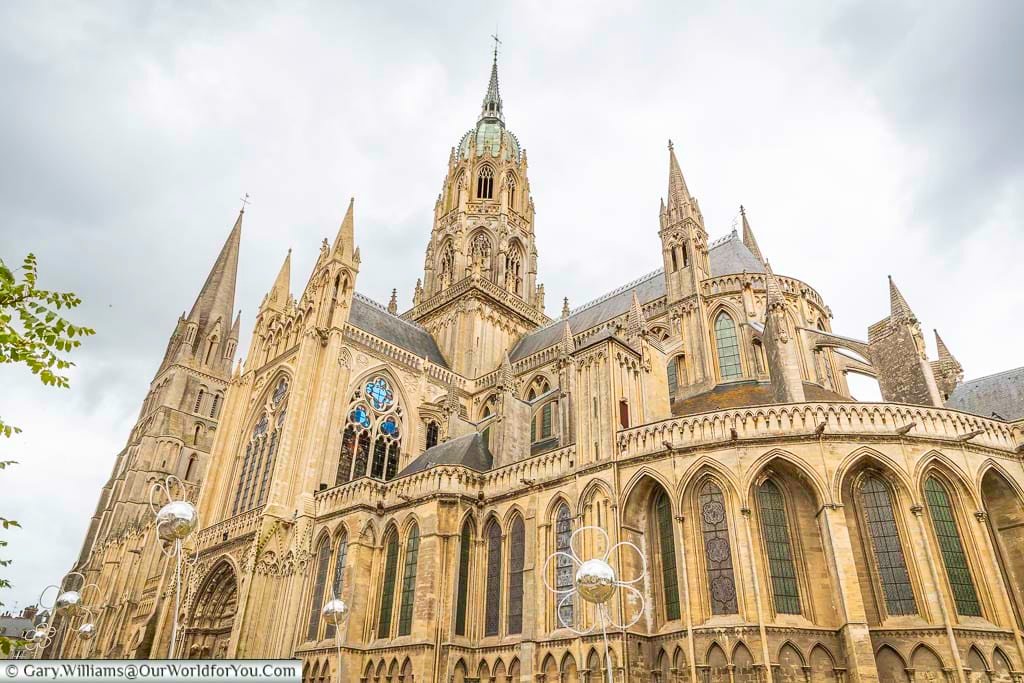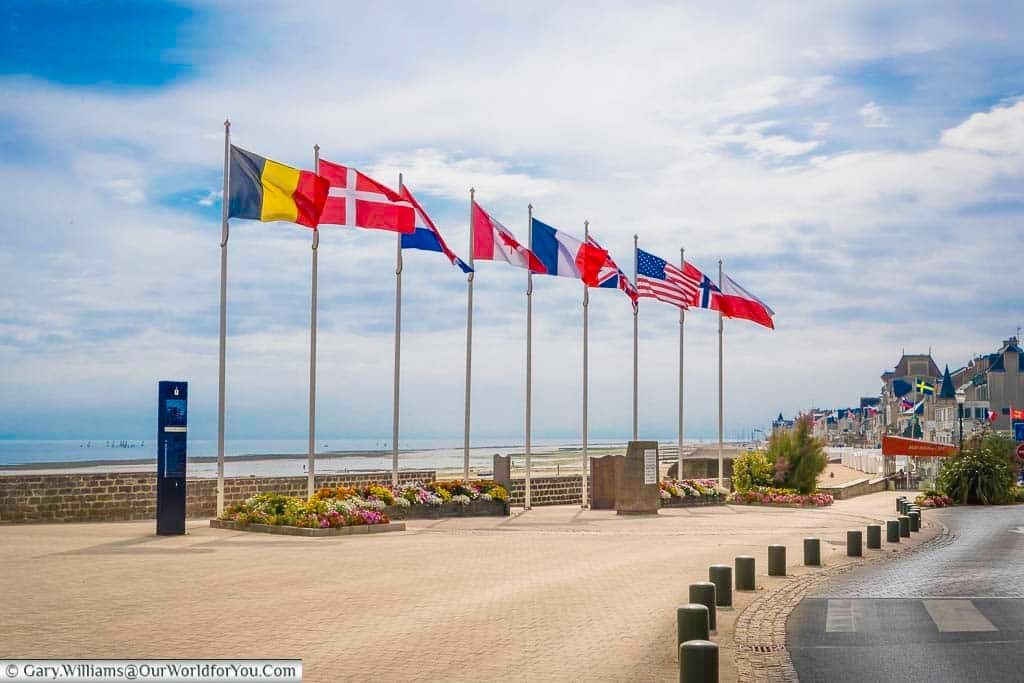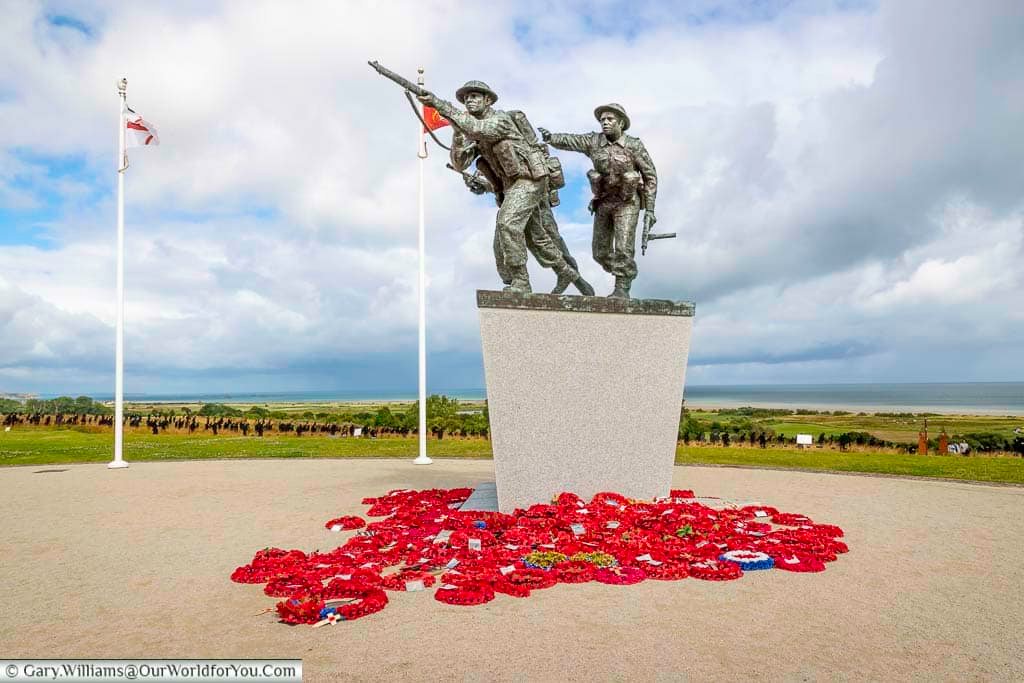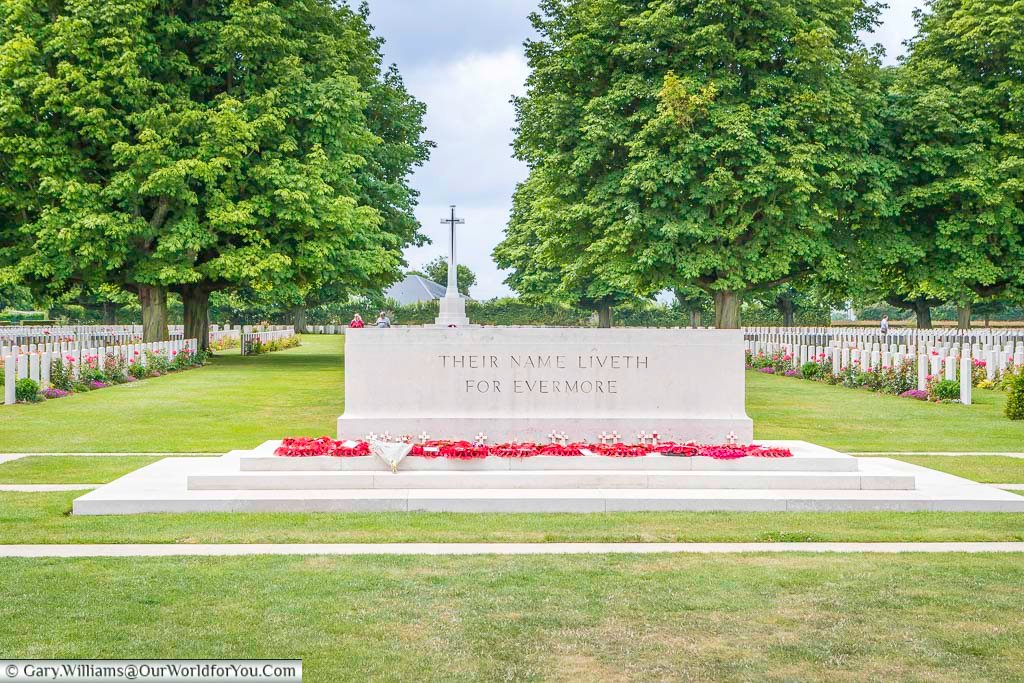A perfect mini-break in Normandy
The picturesque city of Bayeux in Normandy is the perfect location for a mini-break and to base yourselves while exploring D-Day landing beaches. There is an incredible amount of rich history to be discovered in north Normandy; this was our inspiration.
We’d briefly visited Bayeux in Normandy many years ago and with my parents. However, after watching the 80th D-Day anniversary commemorations and the touching “Standing with Giants” installation at the British Normandy Memorial it was time to return to Bayeux.
We’re lucky to have visited the beautiful region of Normandy in northwest France on a number of occasions. The magnificent rolling countryside and the incredible coastline are a joy to explore; however, for us, the poignant history of this region of France regularly draws us back.
We didn’t really need another excuse to enjoy a city break in Bayeux. Nevertheless, this trip also gave us the opportunity to stretch the legs of our new electric vehicle, a Polestar 2. So, with a little planning, our EV mini road trip to Normandy was afoot.

Where is Bayeux?
How to get to Bayeux
- By Car
Departing from the UK to France, there are various options. You can either jump on Le Shuttle and arrive in Calais in 35 minutes or enjoy a leisurely cruise on the open waves with DFDS or P&O. Alternatively, you can head down to the south coast of England and catch Brittany Ferry directly to Normandy.
- By Air
If you’re flying into France, search for your flights in one easy place with Booking.com. This reliable travel search engine will scan for your favoured routes and chosen dates. Pre-book your hire car from Rental Cars, and your adventure begins.
Stay informed
Brief history of Bayeux
A city with a legacyI imagine that as soon as you hear the city of Bayeux mentioned, your immediate thoughts are of the Bayeux tapestry, and why wouldn’t you? It’s world-famous. However, this charming city has so much more to offer.
Bayeux is located in the northwest region of Normandy, and it lies in the Department of Calvados, home of the delicious cider and brandy, it is also the capital of the Bessin area of Normandy.


Bayeux’s historic roots wend their way back to Roman times during the 1st century BC; however, no physical remains can be found today. Bayeux has experienced some tumultuous times over the centuries, and although it became a walled city by the end of the 3rd century, the Viking raids destroyed large areas within the walls, and the ramparts were removed during the 18th century.
The Bayeux Tapestry, which depicts the events leading up to the Norman Conquest of England in 1066, was believed to have been completed within a few years of the infamous Battle of Hastings.

Fast-forward to the atrocities of the Second World War, and on 7th June 1944, Bayeux was the first city of the Battle of Normandy to be liberated by British troops of the 50th (Northumbrian) Infantry Division.
The Bayeux War Cemetery, located southwest of Bayeux, is France's largest British and Commonwealth cemetery from the Second World War.
Where to stay in Bayeux
The Hôtel d'Argouges is centrally located, just a short stroll from the historic Old Town and many of Bayeux’s significant sights.
This beautiful 18th century house has many of its original and traditional features, and has a charming, peaceful garden to relax in, after a long day exploring the city. Hôtel d'Argouges has plenty of onsite parking, which is free of charge.
Alternatively, pop your dates in the Booking.com search box and discover further options for all budgets.
Exploring the quaint streets of Bayeux
In the footsteps of medieval history

On the several occasions we’ve visited or passed through this region of Normandy, I always feel welcome, and the locals openly embrace visitors from near and far.
As we stroll along Rue Saint Martin in Bayeux, fluttering high above us is bunting of the allied nations, large flags lining apartment windows and shopfronts decorated with fun caricatures, to put a smile on your face.


At Pont Saint Jean, you can enjoy the attractive view along the River Aure, with beautiful bright flower displays tumbling over the edge of the bridge and Bayeux Cathedral beyond.
On the opposite side of the bridge, stroll behind the tourist office, and you’ll discover a picturesque watermill and a lovely, peaceful riverside walk.

We love visiting France and each region so different from one another. I find the DK Eyewitness Guides really helpful in planning a trip and so often find interesting little snippets of info.
Take a peek at this revised Top 10 Pocket Travel Guide and see what you can discover.
Visiting the Bayeux Cathedral
Stay for the evening in Bayeux


The Notre Dame Cathedral was consecrated in the presence of William the Conqueror, Duke of Normandy, on 14th July 1077. The upper section of Bayeux Cathedral is built in the Gothic style, with a copper-clad tower at its pinnacle, now in the weathered verdigris tones.
The lower sections of the cathedral are Romanesque and are believed to date from the time of Bishop Odo. Legend has it that the Bayeux Tapestry was originally displayed in Bayeux Cathedral.



Visiting the Bayeux Tapestry
A handcrafted masterpieceFirst and foremost, you need to go and see the Bayeux Tapestry for yourself, firstly as it is a stunning slice of our history and magnificent to witness, and secondly, you are not permitted to take photos of the tapestry.
It is believed that the Bayeux Tapestry was originally on display in Bayeux Cathedral; however, today it is housed in its own dark room within the former Grand Seminary building for training priests.

The Bayeux Tapestry is believed to have been made in southern England, within a few years of the infamous Battle of Hastings, when William the Conqueror headed across the English Channel from Dives-sur-Mer and arrived in Pevensey in autumn 1066.
This incredible historical masterpiece is in fact an embroidery, stitched on linen, rather than a tapestry. The Bayeux Tapestry is breathtaking and illustrates the events leading up to the Norman Conquest.

The Bayeux Tapestry is kept safely behind glass and is handcrafted on one piece of linen, it is 70 metres (230 ft) in length and 50cm (20 inches) in height.
It’s important to select the audio guide when you visit the Bayeux Tapestry as it shares with you the detailed story of William, Duke of Normandy and the events that followed.
Normandy Tourist Information
Our video of Bayeux
We have created a little YouTube video of Bayeux. Why not take a look?
Also, why not subscribe to our YouTube channel and get the latest clips as we post them?
Exploring WWII Normandy history
Bayeux is the perfect baseBayeux is the perfect location to base yourself if you want to explore Normandy’s Second World War history. It is also ideal for visiting the D-Day landing beaches and Pegasus Bridge.
As mentioned, we have visited Normandy on a number of occasions and headed to the D-Day Landing beaches of Sword Beach in the east and touring west to Juno, Gold, Omaha and Utah. However, since we last visited north Normandy, the British Normandy Memorial has been opened by Gold Beach in Ver-sur-Mer.

The British Normandy Memorial is stunning to see, and it fills you with so much pride when you arrive. I’m sure, like me, you’ll feel a lump in your throat; it is so touching.
The ‘Standing with Giants’ installation has now been moved to Stowe Gardens, National Trust site in Buckinghamshire; however, the silhouettes are hoping to return in 2025.

Another WWII memorial you should visit in Bayeux is the Bayeux War Cemetery and Memorial, just a 15-minute walk from the historic city centre. It is beautifully kept and so incredibly peaceful and poignant.
The Bayeux Cemetery is the largest British and Commonwealth cemetery in France with casualties from the Second World War. It contains 4,144 Commonwealth burials, 338 of them are unidentified. There are also over 500 war graves of other nationalities, of which over 400 are German soldiers.

Crit'Air vignette required for driving in France
If you’re heading to France from the UK with your own vehicle, you’ll need a Crit’Air ‘clean air’ car sticker.
Just like our low-emission zones in the UK, France now legally requires the display of a Crit’Air vignette. The good news is, these stickers are readily available and affordable online through the official French government website.
The Crit’Air sticker lasts the lifetime of the vehicle, so it’s a one-off purchase. The RAC website offers an in-depth guide to everything you need to know and your requirements.
Why not check out more on Normandy

Our itinerary for a Normandy road-trip via Rouen, Caen & Alençon
An idyllic 10-night journey

Roadtrippin’ memories of Normandy, France
History, cider, crepes & art, what more could you want?

Visiting Le Mont-Saint-Michel, Normandy, France
Don’t get caught by the tide…
* This post may contain links to affiliated sites where we earn a small commission at no additional charge to you.




